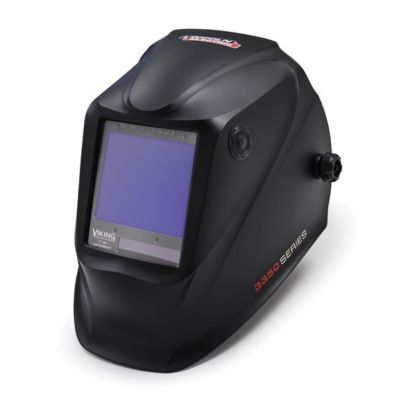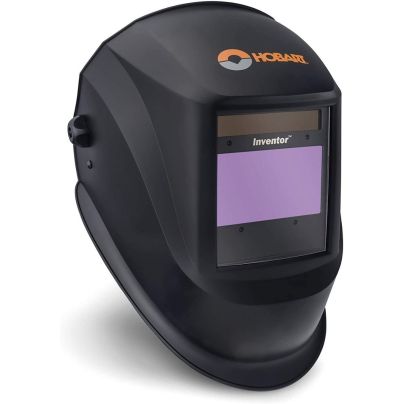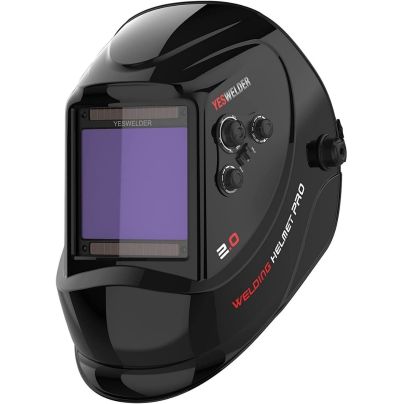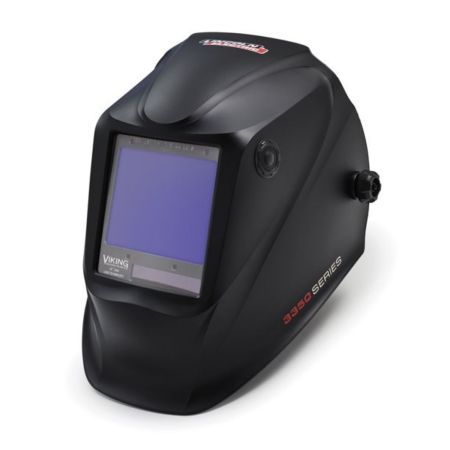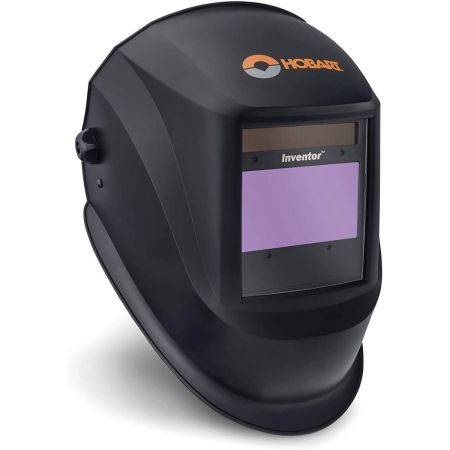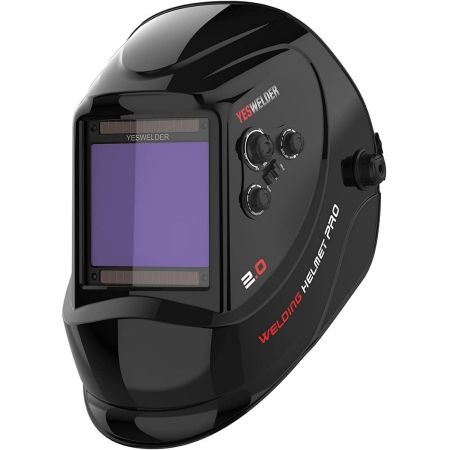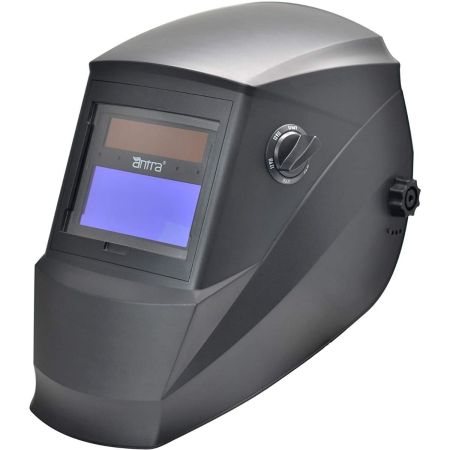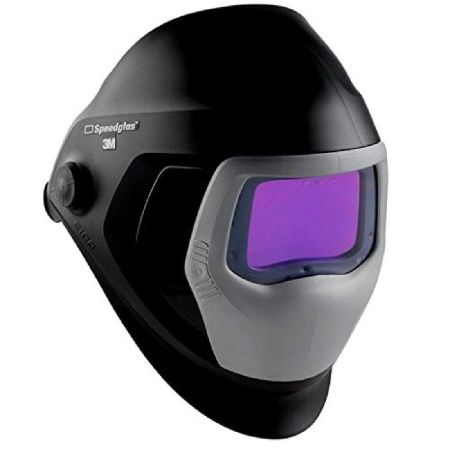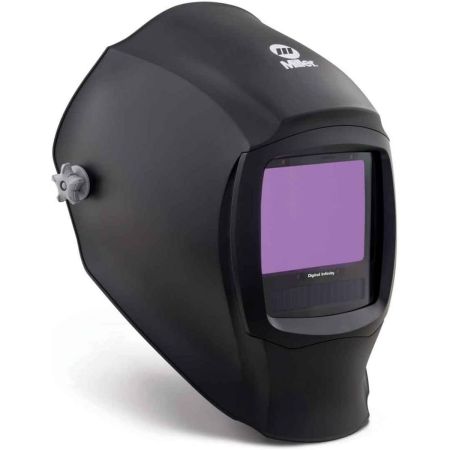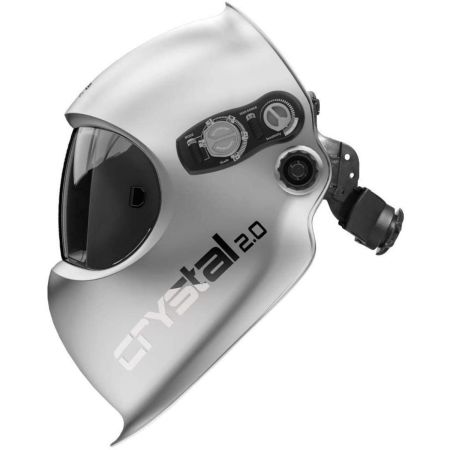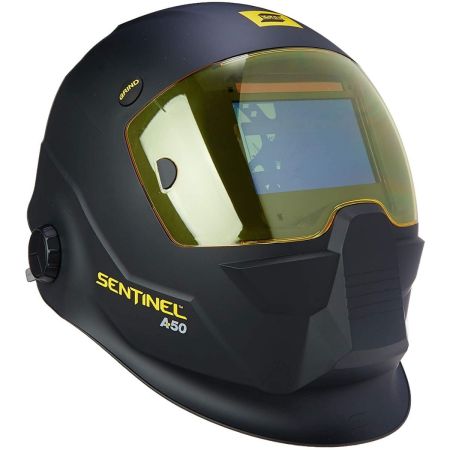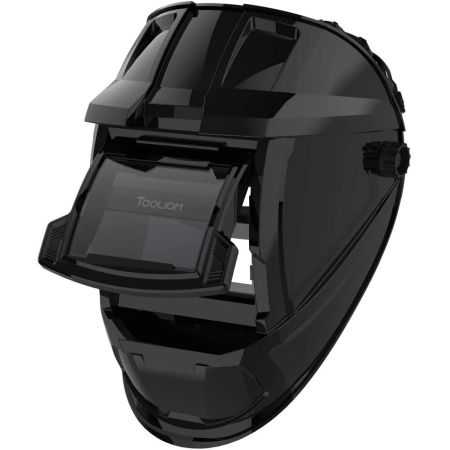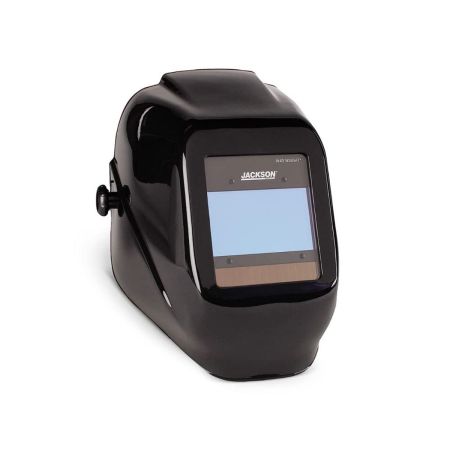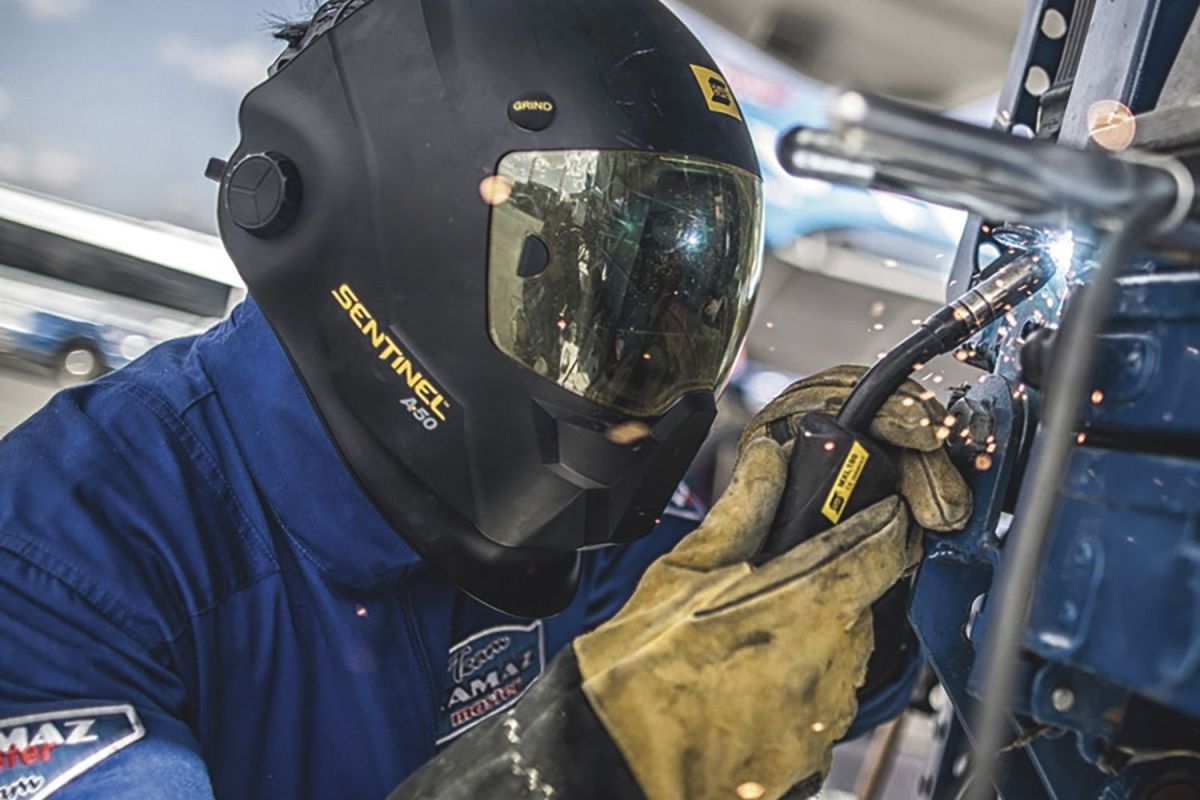
We may earn revenue from the products available on this page and participate in affiliate programs. Learn More ›
Regardless of the welding process being used, or the welder’s skill, a proper safety helmet must always be worn. No exceptions. Not doing so could result in serious burns and temporary or even permanent blindness.
Fortunately, welding helmets are available for all budgets, so there’s no excuse not to buy one. That said, the specifications can be confusing, making it difficult to choose the right model, particularly for beginner welders. The following article demystifies the technology and helps identify the best welding helmets for a wide variety of needs.
- BEST OVERALL: Lincoln Electric K3034-4 VIKING 3350 Auto Darkening
- RUNNER-UP: Hobart 770890 Auto-Darkening Welding Helmet
- BEST BANG FOR THE BUCK: Yeswelder Large Viewing Screen 3.94X3.66″ True Color
- BEST LOW-COST: Antra Wide Shade Range 4/5-9/9-13 Auto Darkening Weld
- BEST LIGHTWEIGHT: 3M Speedglas Welding Helmet 9100, 06-0100-30iSW Auto
- BEST VIEW AREA: Miller 280045 Black Digital Infinity Series Welding
- BEST HIGH-END: Optrel Crystal 2.0 Auto-Darkening Welding 1006.900
- BEST TECHNOLOGY: Esab 0700000800 Sentinel A50 Welding Helmet Black Low
- BEST FLIP-UP: Tooliom Flip Up Welding Helmet 3.64 x 1.67 inch Auto
- ALSO CONSIDER: Jackson Safety Insight Auto Darkening Welding Helmet
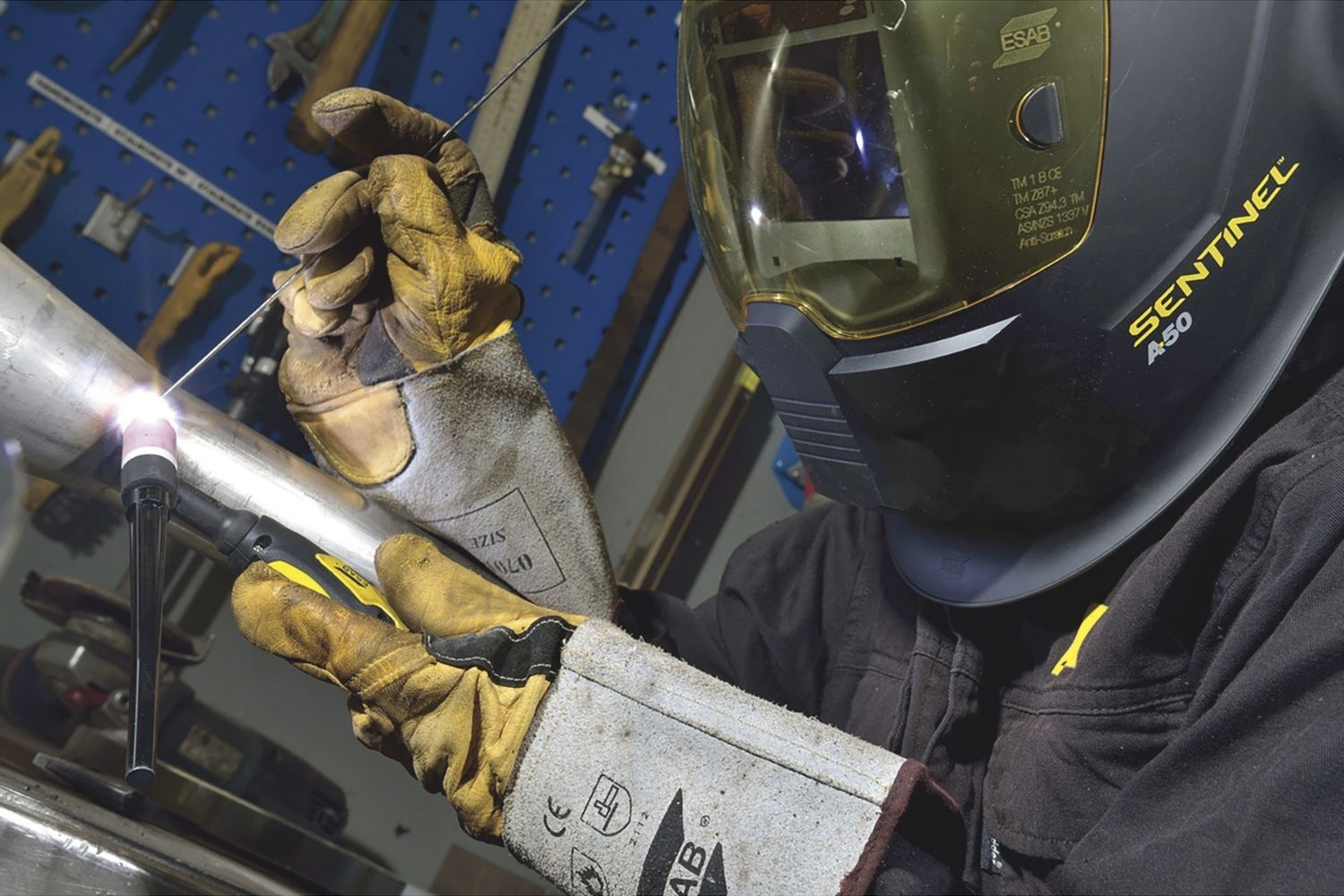
Types of Welding Helmets
All welding helmets can be divided into two basic categories: passive or auto-darkening. This distinction refers to the glass that the welder looks through. It is often called the lens, view screen, or viewing screen.
Passive
A welding helmet with a passive lens is fitted with a piece of darkened glass of a fixed shade (more on shades below). Initially, all welding helmets were passive, and this type still has the advantages of light weight, simplicity, and low cost. A basic hand-held welding mask (commonly used by supervisors or students watching a welder work) also falls into this category.
However, the shade of the lens limits the passive helmet to only one type of welding. For greater versatility, the lens would need to be changed manually. In order to examine the weld properly, it is also necessary to lift the helmet up. This can quickly get frustrating and is potentially dangerous if other welders are working nearby.
Auto-Darkening
Auto-darkening welding helmets have a much more complex lens that includes liquid crystal layers linked to three or four sensors. The sensors detect the brightness of the weld arc when starting, and darken the lens automatically. This happens extremely rapidly, in 1/10,000 second or less, thus protecting the eyes from damage. When the welder stops, the lens clears so the work can be checked without needing to raise the helmet.
Batteries are fitted to power auto-darkening welding helmets, which can increase weight though many remain very light. Auto-darkening welding helmets are more expensive than passive models but their versatility and convenience makes them by far the more popular choice.
What to Consider When Choosing the Best Welding Helmet
The versatility of modern welding helmets means there are seldom any bad choices. That said, various factors can make one model more appropriate for a particular user than another. Understanding these key features will enable buyers to focus on the best welding helmet in terms of both performance and value.
Viewing Area and Clarity
In early welding helmets, very thick glass was needed to offer adequate protection. As a result, welders peered out through a tiny slot. Many passive welding helmets still have a relatively small viewing area (lens size). On auto-darkening models, this is usually larger, providing a better view not just of the weld but of the adjacent area.
Viewing area is usually given in square inches (sq. in.), and it is important to check figures carefully. Some modern welding helmets have large wraparound visors, but these can be deceptive because the actual viewing area may be much smaller.
Focus is usually forwards when welding, so peripheral vision may not be a significant factor. However, it can be useful in busy working environments. Some high-end welding helmets offer this feature.
Lens distortion is not unknown. In cheap welding helmets, the image may be slightly blurred or rippled. A rating system checks clarity using four reference points. An optically perfect welding helmet gets a score of 1/1/1/1. One with a small but negligible flaw would rate 1/1/1/2, for example. Either of these is normally considered acceptable by professionals. On many welding helmets, the use of shades means the lens doesn’t reproduce exact color, so what the welder sees may have a slight tint (typically green). True color systems attempt to correct this and show lifelike color.
Shade Range
Shade range (the number of steps of darkening provided) is usually given using a # symbol and a number, with lower numbers being closer to clear and higher numbers being darker. For instance, #3 is used for grinding or brazing, processes that produce minimal harmful light. At the other end of the scale, #14 is used for carbon arc welding, which can reach 9,000 degrees Fahrenheit. It produces an extremely bright and very harmful light. It is a specialist process, so few welding helmets have shade ranges that high.
Reading shade ranges can sometimes be confusing. While often #7 – #12 (or simply 7-12) might be shown, it’s not unusual to see something like 3/4-9/9-13. This is a welding helmet with multiple shade ranges for different functions, showing the shade for grinding (#3), the shades for cutting (#4 to #9), and the shades for welding (#9 to #13).
An auto-darkening welding helmet has sensors that trigger the user-selected shade as soon as relevant brightness is detected, or once the weld has finished when the helmet goes back to clear again. However, changes in ambient light (from morning to evening, for example) can mean factory settings don’t match a particular welder’s preferences. This applies whether the welding hood is going from light to dark, or back to light again. Arcs from other welders working close by, or even sunlight, might also set off the helmet. To combat this, many of the best auto-darkening welding helmets offer adjustable sensitivity, and/or the ability to change the helmet’s reaction time (usually called the delay or switching speed).
Power Source
All auto-darkening welding helmets need one or more batteries to operate. These may be replaceable, and either standard or rechargeable cells can be used.
The alternative is a solar welding helmet, and these are now common. They are easily identified by the small band of solar panels either above or below the view screen. These don’t need sunlight, as they can collect light generated by the welding arc. However, they don’t power the helmet directly—they charge internal batteries.
Solar welding helmets can be very convenient, but the battery compartment is often sealed. So when the batteries eventually die (usual life expectancy is about 7 years), the entire helmet must be replaced.
Weight and Comfort
A heavy welding helmet can cause neck and shoulder pain if worn for long periods. So generally speaking, a lighter model is better as long as it provides sufficient physical coverage to prevent burns from flashes or welding spatter (molten metal spat out during welding).
The other major consideration in terms of comfort is the headgear (harness) inside the welding helmet. Some welders like to wear a flame-retardant welding bandana to protect head and ears, so the amount of adjustability must accommodate this. Brow and neck padding should be considered, plus the number of contact points with the head. The more contact points, the more evenly the load is spread. Welding can be very hot work, making ventilation a popular extra.
Safety
Working with strong electrical currents and molten metal at several thousand degrees is inherently hazardous. In addition, some welding environments may be dangerous. All welding helmets should offer protection from ultraviolet (UV) and infrared (IR) light, and prevent facial and neck burns; some take safety even further.
The view screens on many of the best welding helmets may meet the same standard as expected for safety glasses, which is ANSI/ISEA Z87.1. Some also offer a high level of impact protection and may meet ANSI/ISEA Z89.1, the standard for industrial headgear and hard hats. This can either mean the structure of the welding helmet itself has the required strength, or that it qualifies when used in conjunction with a hard hat meeting that standard.
We would recommend avoiding garage sale bargains or second hand welding helmets. There is no easy way to check their structural integrity or auto-darkening function.
Arc Sensors and Additional Features
Keep the following features in mind when evaluating welding helmets:
- Arc sensors acquire information about the workpiece to enhance precision. The number of arc sensors can affect the reaction time and sensitivity of the welding helmet. Better models have three or four, but some low-cost helmets only have two.
- Grinding is often required to clean up a weld, and while the process is not as bright as welding, some protection is a good idea. Some welding helmets have a convenient grind mode operated by a separate button.
- Some welders find it uncomfortable to wear prescription glasses under a welding helmet. One solution is a so-called “cheater lens,” a thin magnifier designed to fit over the lens area. These are inexpensive and available for most (but not all) welding helmet models.
Our Top Picks
The valuable background information above will be helpful when reading up on what we consider to be the best welding helmets in their respective categories currently available.
Best Overall
Lincoln Electric K3034-4 VIKING 3350 Auto Darkening
The Lincoln Electric Viking 3350 ranks highly with users and in independent reviews for good reason. Its superb lens, among the largest available, is rated optically perfect at 1/1/1/1, and it uses what Lincoln Electric calls 4C Technology to reproduce truly lifelike color. It auto-darkens in 1/25,000 second. In addition to the wide shade range, there are controls for sensitivity and delay that offer a high level of customization and fine control. The convenient grind mode button on the side of the helmet must be pressed for 3 seconds to avoid accidental activation.
There is very little to fault with the Lincoln Electric Viking 3350. The X6 headgear offers good comfort, although we have seen reports that the tightening knob occasionally works loose. While the price is competitive given its feature set, we expect it will be more than many hobby welders want to pay.
Product Specs
- Viewing area: 12.5 sq. in.
- Shade range: #5 to #13
- Weight: 1.4 pounds
Pros
- Extra large lens
- Excellent clarity and true color
- Precise control
Cons
- Expensive
- Occasional headgear faults
Get the Lincoln Electric welding helmet on Amazon or at Walmart.
Runner-up
Hobart 770890 Auto-Darkening Welding Helmet
Hobart is one of the world’s leading welding equipment manufacturers, with a reputation for high-quality, reliable equipment. The Hobart 770890 welding helmet (also known as the Hobart Inventor) is priced to appeal to the amateur, yet it has all the features a professional would look for.
The lens isn’t as big as that on the Lincoln Electric, but it is by no means small. It is optically perfect at 1/1/1/1, though color shows a slight green tint. Auto-darkening occurs in 1/25,000 second and there is adjustment for both sensitivity and delay. There is also a grind mode, but it’s inside the helmet, meaning it has to be flipped up in order to activate it.
Made from tough polyamide nylon, the Hobart Inventor is designed to survive the kind of treatment it’s likely to get in a busy shop. The headgear is notable for its all-day comfort.
Product Specs
- Viewing area: 9.3 sq. in.
- Shade range: #8 to #13
- Weight: 1.25 pounds
Pros
- Renowned quality and reliability
- High comfort levels
- Good value
Cons
- Not true color
- Grind mode button inside helmet
Get the Hobart welding helmet at Tractor Supply Co. or on Amazon.
Best Bang for the Buck
Yeswelder Large Viewing Screen 3.94X3.66u0022 True Color
Yeswelder welding products are known for providing good value for the money. This welding helmet has many of the features found on more expensive models and boasts the largest viewing area of any we considered. Colors are good, if not exceptional, and while 1/1/1/2 optical clarity isn’t perfect, it is still to a professional standard.
Auto-darkening speed is 1/10,000 second, which is slower than some but still perfectly safe. Controls for shade, delay, sensitivity, and grinding mode are all on the outside of the helmet and designed to be used with gloved hands.
This Yeswelder welding helmet lacks the construction quality of leading brands, it is heavier than many, and the headgear could be more supportive. Nevertheless, the combination of low price and a competitive feature set makes it one of the best welding helmets for the money available.
Product Specs
- Viewing area: 14.38 sq. in.
- Shade range: #5 to #13
- Weight: 2.2 pounds
Pros
- Comprehensive feature set
- Easy-to-use controls
- Very affordable
Cons
- Headgear could be improved
- Some durability concerns
Get the Yeswelder welding helmet on Amazon or at Walmart.
Best Low-Cost
Antra Wide Shade Range 4/5-9/9-13 Auto Darkening Weld
Antra’s low-cost welding helmet is aimed at beginners and those who don’t weld regularly but still want the convenience of auto-darkening. Though it can’t compete with high-end models on some levels, it’s a versatile helmet with a wide shade range, grinding mode, and adjustment for sensitivity and delay. Reaction speed is good at 1/25,000 second.
The lens is on the small side with optical clarity at 1/1/1/2, and there’s a noticeable green tint while welding. Most users find this Antra’s headgear comfortable. Though it also has fittings for hard hats, it doesn’t have much structural rigidity itself. The Antra welding helmet is not designed to stand up to professional use. While many prove reasonably durable, faults are not unknown.
Product Specs
- Viewing area: 6.7 sq. in.
- Shade range: #5 to #13
- Weight: 1.3 pounds
Pros
- Adjustable for sensitivity and delay
- Hard hat compatible
- Very low cost
Cons
- Not for everyday use
- Pronounced green tint
Get the Antra welding helmet on Amazon or at The Home Depot.
Best Lightweight
3M Speedglas Welding Helmet 9100, 06-0100-30iSW Auto
The 3M Speedglas welding helmet has an interesting design that incorporates a large screen and side windows for excellent all-round visibility. Its light weight, combined with highly adjustable headgear and exhaust vents, make it perhaps the most comfortable of our top picks.
It has all the features expected of a premium-quality welding helmet, including variable sensitivity and delay, plus an external button for grind mode. The 3M Speedglas also offers auto-on when the helmet is picked up, with a memory function that remembers the last settings used.
The 3M Speedglas incorporates what the company calls Natural Color Technology for a lifelike view, but while optical clarity appears very good, we were unable to find an actual rating—a surprise given how expensive the helmet is. It also has relatively slow 1/10,000 second auto-darkening.
Product Specs
- Viewing area: 11.76 sq. in.
- Shade range: #5 to #13
- Weight: 1 pound
Pros
- Very light and comfortable
- Good peripheral vision
- Exhaust vents for cooling
Cons
- Very expensive
- Headgear a little complicated
Get the 3M welding helmet on Amazon.
Best View Area
Miller 280045 Black Digital Infinity Series Welding
Miller is another brand known for high-quality welding equipment. The Miller Digital Infinity has a particularly large view screen, and though the one on the Yeswelder is slightly bigger and clarity is the same at 1/1/1/2, Miller’s ClearLight technology provides superior color accuracy.
An interesting feature of the Miller Digital Infinity is its X-mode. This senses the welding arc electronically, rather than by brightness, so sunlight won’t interfere with performance as it can with some welding helmets. Auto-darkening speed is 1/20,000 second. The LCD control panel, which also handles delay and sensitivity settings, is particularly clear, easy to use, and offers great precision.
The Miller Digital Infinity is heavier than many competitors. Although the headgear is designed to provide good comfort and is well padded, a number of users report it just doesn’t work as well as intended.
Product Specs
- Viewing area: 13.4 sq. in.
- Shade range: #5 to #13
- Weight: 1.9 pounds
Pros
- Large screen with excellent color
- X-mode prevents sunlight interference
- Easy-to-use controls
Cons
- Headgear could be better
- Premium price
Get the Miller welding helmet on Amazon or at Walmart.
Best High-End
Optrel Crystal 2.0 Auto-Darkening Welding 1006.900
Optrel specializes in industrial protection equipment and has a well-earned reputation for high quality and attention to detail. While the Optrel Crystal 2.0 welding helmet is undeniably expensive, it has some unique, user-friendly features.
The helmet takes its name from its exceptional clarity. It is rated 1/1/1/1, and often noted as the clearest lens on the market in independent reviews. Color reproduction is also outstanding. Although the lens isn’t as large as some, this doesn’t impact usability. Reaction speed is 1/10,000 second.
Controls for shade, sensitivity, delay, and grind mode are on the outside for easy access without removing the helmet. The shell of the Optrel Crystal 2.0 offers extended neck protection and is covered in heat-resistant paint for cool comfort. There is also an integrated particle filter to protect the user from smoke and dust.
Product Specs
- Viewing area: 8.5 sq. in.
- Shade range: #4 to #12
- Weight: 1.1 pounds
Pros
- Outstanding clarity and color
- External controls
- Heat-reflective paint
Cons
- Expensive
- Does not accept cheater lenses
Get the Optrel welding helmet on Amazon.
Best Technology
Esab 0700000800 Sentinel A50 Welding Helmet Black Low
The Esab Sentinel A50 welding helmet makes an immediate visual impression, but there are practical aspects to the tough, impact-resistant shell beyond its sleek, stylish appeal.
The central pivot in the ergonomic headgear, plus low-profile shape, keep the shell close to the head when raised. This makes it ideal for industrial welding applications when overhead space is limited. In addition to improved head and neck protection, it also provides good peripheral vision. A hard-hat adapter is available at additional cost. The curved shape can occasionally reflect glare, though this seldom affects the actual lens area.
Another outstanding feature of the Esab Sentinel is the superb touch-screen control panel. This allows absolute precision when setting shade, delay, and sensitivity, and it can store eight different setting combinations for rapid access. Optical precision is 1/1/1/1, and colors are true. Reaction speed is 1/25,000 second.
Product Specs
- Viewing area: 9.27 sq. in.
- Shade range: #5 to #13
- Weight: 1.4 pounds
Pros
- Eight memory settings
- Impact-resistant shell
- Eye-catching design
Cons
- Occasional screen glare
- High price
Get the Esab welding helmet on Amazon or at Northern Tool + Equipment.
Best Flip-up
Tooliom Flip Up Welding Helmet 3.64 x 1.67 inch Auto
Despite so-called clear view technologies, many welders will still lift their welding hood to inspect their work, or to do a quick bit of filing or sawing. While all welding helmets provide this facility, the raised portion makes movement awkward. The Tooliom Flip Up helmet offers a quick and easy alternative, with just the lens section lifting out of the way.
Specifications for the Tooliom Flip Up are on a par with many other budget models. Optical clarity is rated as 1/1/1/2. TrueColor technology has improved color accuracy over previous models, though there is still a slight blue/green tint. Reaction time is 1/10,000 second. Controls are straightforward, though the manual dials lack the precision of digital displays.
Although the flip-up section does reduce screen size, it is still larger than most passive welding helmets. It’s also a little heavier than most, but the headgear provides adequate support. Given the low cost, the Tooliom Flip Up Welding Helmet is an interesting option for beginners or those who only weld occasionally.
Product Specs
- Viewing area: 6.08 sq. in.
- Shade range: #5 to #13
- Weight: 2 pounds
Pros
- Convenient flip-up lens
- Simple controls
- Very low cost
Cons
- Modest viewing area
- Comparatively heavy
Get the Tooliom welding helmet on Amazon.
Also Consider
Jackson Safety Insight Auto Darkening Welding Helmet
In many ways, the Jackson Safety Insight welding helmet is much like many other affordable, midrange models. It has high optical clarity rated at 1/1/1/1 and uses True Color technology for accurate representation. Reaction time is 1/15,000 second, and there are accurate digital controls for all major functions including delay and sensitivity. It would be a good choice for both hobbyists and general-purpose professional welders.
Where the Jackson Safety Insight differs from most other models is its narrow design, which gives it an advantage when working in tight spaces. While it is a little heavy, comfort is maintained with well-padded headgear that has a large dial for rapid adjustment.
Unfortunately, while a grind mode is provided, there is no shade range for cutting. Some also feel the Jackson Safety Insight welding helmet offers less neck protection than other models.
Product Specs
- Viewing area: 9.27 sq. in.
- Shade range: #9 to #13
- Weight: 2 pounds
Pros
- Accurate digital control
- Slender profile for working in tight spaces
- Good value
Cons
- Limited neck coverage
- Not for cutting
Get the Jackson Safety welding helmet on Amazon or at Walmart.
Our Verdict
Though pricey, the Lincoln Electric welding helmet is almost flawless, and it has all the features the keen amateur or professional needs in a welding helmet. The Yeswelder welding helmet is an affordable option for the home welder wanting a fully featured welding hood.
How We Chose the Best Welding Helmets
I am an engineer by profession, and while not a full-time welder I have extensive experience with the processes and equipment. The Bob Vila team also researched all of the leading manufacturers to ensure they were current with the latest technologies. Feedback from hundreds of real-world users was considered too.
- Performance: This pertains to how well the welding helmet does its job of protecting the welder without impeding work. It takes into account versatility, adjustability, and comfort. The factors covered in the considerations section above informed our choices, and we looked for models that were appropriate for a variety of different users.
- Durability: Welding helmets should have an operating life of around 7 to 10 years, but elements can fail ahead of time. If we found significant instances of this, regardless of whether the error or component could be fixed, that model didn’t make the cut.
- Value: With safety equipment like welding helmets, low price alone was not our main concern. Instead, all welding helmets chosen—including budget-friendly models—had to provide quality. That said, a more affordable welding helmet might well be the right choice for a hobbyist but may not offer all the features a professional user needs. A welding helmet that costs several hundred dollars can still be a good value for a pro. We looked for a selection of top models across the entire price range.
FAQs
The technical aspects to be considered when shopping for the best welding hoods have been covered above, and a range of worthy alternatives were provided. Those who still have questions may find the information they need below.
Q. What welding helmets are better for beginners?
Affordable models like those from Antra and Yeswelder are suited to beginners who intend for welding to be a hobby. Beginners looking to weld professionally would perhaps be better off investing in a high-quality model like the Lincoln Electric from the start.
Q. What shade is best for welding?
It depends on the welding process used, which is why the best welding helmets have multiple shade options.
Q. Does welding ruin your eyes?
The bright light from a weld can cause a painful condition called welder’s flash or arc eye. Molten metal also presents an obvious danger. However, when worn properly, all of the welder’s helmets recommended above will prevent eye damage so users can weld safely.
Q. How long do welding helmets last?
Those with non-replaceable batteries should last around 7 years if looked after. Those with replaceable batteries can be expected to last about 10 years.
Q. Why do welders wear welding helmets?
A welding helmet prevents damage to the eyes from the infrared and ultraviolet light given off by the welding arc. A helmet also protects the face from burns caused by welding sparks or molten metal flashes.
